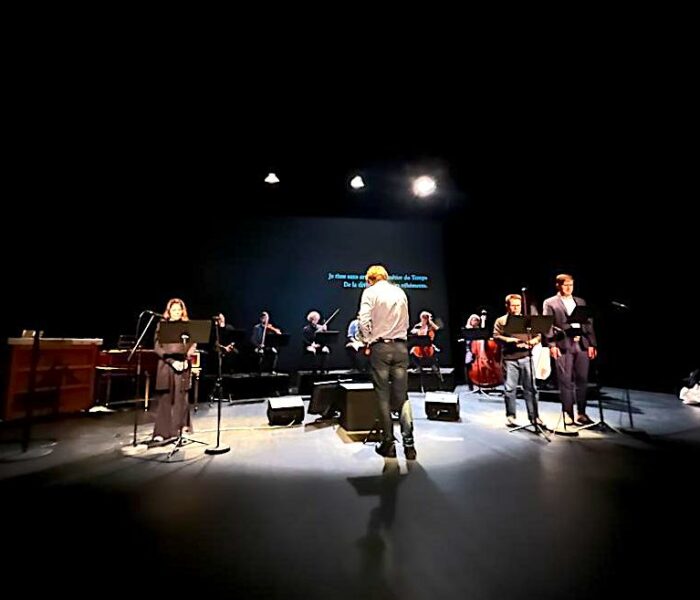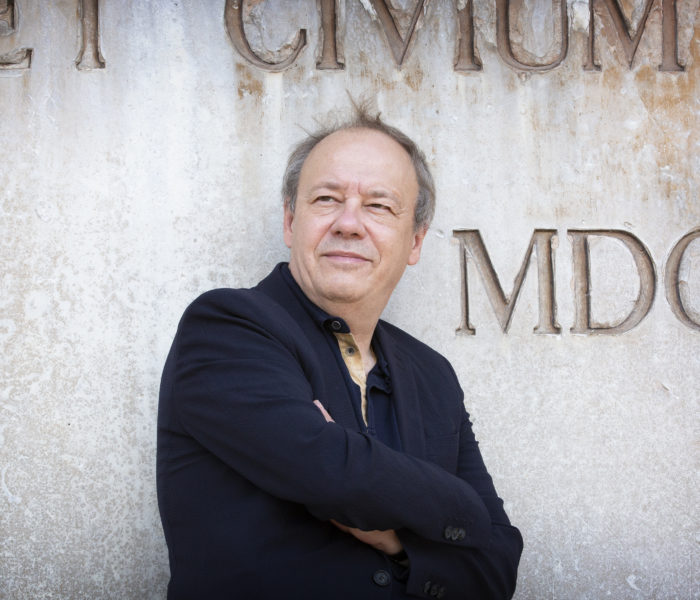Le théâtre des Bouffes du Nord retrouve son public avec une nouvelle production du Viol de Lucrèce de Benjamin Britten mis en scène par Jeanne Candel. Les musiciens de l’ensemble Multilatérale et de l’Orchestre-Atelier Ostinato partagent le plateau du Théâtre des Bouffes du Nord avec les chanteurs, tous jeunes et en résidence à l’Académie de l’Opéra national de Paris. Maitre d’œuvre de la soirée, Léo Warynski fait, quant à lui, ses débuts à l’Opéra de Paris.
Écrit au lendemain de la guerre, deux ans seulement après son chef d’œuvre Peter Grimes, The rape of Lucretia (Le viol de Lucrèce) est le premier opéra de chambre de Benjamin Britten dont il faut souligner l’économie de l’effectif : deux voix seulement pour le chœur mixte et un ensemble instrumental (incluant une harpe et un piano), de treize musiciens aux côtés de huit chanteurs.
Le livret de Ronald Duncan, tiré de la pièce d’André Obey (s’inspirant lui-même de Shakespeare) nous plonge dans cette époque troublée de l’histoire romaine (509 av. J-C) durant laquelle le viol de Lucrèce par Tarquinius, viol qui pousse la victime au suicide, déclenche la révolte d’un peuple tenu sous le joug des Étrusques. « L’avènement de la République romaine se fait sur le corps d’une femme qui a préféré mourir plutôt que d’endosser la honte et l’opprobre », souligne la metteure en scène Jeanne Candel.
Tandis que les hommes se reposent entre deux combats, leur parvient la rumeur de l’infidélité de leurs épouses. A l’exception de Lucrèce, la femme de Collatinus qui, comme une Pénélope, attend le retour de son mari en filant la laine avec ses suivantes. Mis au défi par Junius, Tarquinius, fou de jalousie et de désir, force sa porte et la viole…
Une tapisserie écrue et cousue main – celle de Lisa Navarro – constitue l’élément principal du décor. Elle est suspendue, masquant l’orchestre durant le premier tableau essentiellement masculin. Tirée par les femmes qui la font descendre, la tapisserie glisse ensuite sur le sol, marquant cette fois le territoire féminin peaufiné par les lumières et nuances colorées de César Godefroy. Le décor fait alors apparaître en fond de scène une sorte de métier à tisser, occupation des femmes lorsque les maris sont au combat.
Dans la tradition anglaise qu’incarne pleinement Britten et l’attention portée à la déclamation, le chœur (deux voix seulement, rappelons-le) est là qui expose les faits, commente les propos des personnages et assure les transitions : un rôle assumé avec beaucoup de souplesse et de vitalité par le ténor suédois Tobias Westman et la soprano non moins chaleureuse Andrea Cueva Molnar. C’est la violence et la rudesse qui dominent le dialogue des trois guerriers dans une première scène forte en gueule. L’Américain Alexander York/ Tarquinius s’impose avec une voix bien timbrée, un rien tonitruante parfois. Le Russe Alexander Ivanov est plus modéré dans ses élans, sans toujours bien contrôler ses aigus. Somptueuse basse au grain sombre et suave que l’on apprécie dans la dernière scène de l’opéra, l’États-unien Aaron Pendleton/Collatinus est moins à l’aise dans les récitatifs que Britten écrit en alternance avec des séquences plus chantées, entre l’arioso et l’air. Ces instants proches du récit font appel au piano, placé à cour et relayant l’orchestre comme le faisait le clavecin dans l’opéra du XVIIIᵉ.
La violence s’entend également dans l’orchestre que Jeanne Candel a voulu proche des chanteurs, au détriment parfois de l’équilibre des forces qui n’est pas toujours idéal. Avec ses relances rythmiques, l’importance accordée aux timbres (harpe, clarinette basse, cor anglais…) et la présence active de la percussion, l’orchestre est un des ressorts principaux du drame, mis en valeur par la direction souple et précise de Léo Warynski.
Le tableau féminin modifie totalement le climat, Britten favorisant les duos et trios des voix féminines dans de très belles pages solistes et chorales auxquels prend part la harpe, métaphore sonore du rouet des fileuses. La mezzo Marie-Andrée Bouchard-Lesieur affirme la personnalité d’une Lucrèce aux accents très expressifs. Domine également, avec toute sa fraicheur et son agilité, la voix lumineuse de Kseniia Proshina/Lucia, dotée d’une belle partie mélodique et souvent associée au mezzo plus incarné de Cornelia Oncioiu/Bianca. La très belle scène des fleurs toute d’innocence et de pureté (elles ne savent rien du viol de la nuit précédente) rend d’autant plus tragique l’arrivée de la victime dans le dernier tableau.
La scène du viol, qui doit être cachée, est plus que suggérée dans la mise en scène de Jeanne Candel qui veut nous en faire ressentir toutes les répliques « comme un tremblement de terre », dit-elle. Le coup de couteau suicidaire, montré sur scène également, n’est pas moins violent dans sa double répercussion, à la fois intime et politique.
Michèle Tosi
Aux Bouffes du Nord à Paris, jusqu’au 29 mai



)






